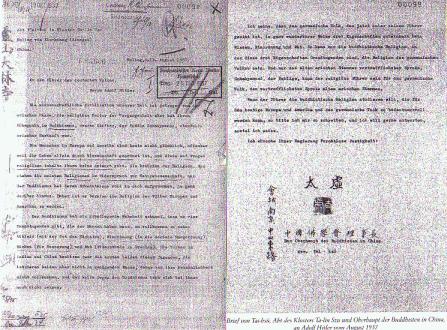Just as the history
of South Asia is of importance to current globalization trends, so also that of
China. An important period in regards to modern China
is from the time it decided to join WWI (creating revolution within its own
borders), until 1921 when it decided to sign a contract with Germany. This, was also the year Mao declared Russia as the ‘most civilised’ country. When Modern
China Woke Up to the World.
Letter to Adolph Hitler by the Chinese Buddhist reformerTaixu signed: "Head of all Buddhists in
China" Click to enter:

An Expose of Cultural Exclusiveness in Modern China
It seems that a
racialization of identity has been central, rather than peripheral, in the
politics of nationalism in China since 1895. Following my presentation below
about Chinese Buddhist reformer Taixu (who wrote a
letter to Hitler), I proceed here with China’s ‘Archeology’ during the Comunist era. Since the erosion of Communist authority
after the Tiananmen incident in 1989, nationalist sentiments have found a wider
audience both within state circles and within relatively independent
intellectual spheres.
Last month Chinese
President Hu Jintao has been visiting the UK, Germany and Spain, in a new
attempt to establish China as a player on the world stage. Comment.
Tribes with Flags: China, from Burma to Turkey
The ancient Chinese
empire visualized its boundaries not as distinct linear borders, but more as
horizons of influence and contact. Now however we have 56 (recognised)
'Nationalities' in China, and a joke circulates that in Turkey, there would be
71 and half nations. Following Beijing I first started with Kun-Ming, before
proceeding to the Tarim Basin near the silk road.
For updates
click homepage here